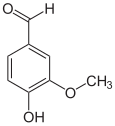Vanillyl alcohol oxidase
| Vanillyl alcohol oxidase ( Penicillium simplicissimum ) | ||
|---|---|---|

|
||
| Ribbon model according to PDB 1VAO ; FAD molecule (red), cap domain (green), FAD binding domain (orange) | ||
|
Existing structural data : 1ahu , 1ahv , 1ahz , 1dzn , 1e0y , 1e8f , 1e8g , 1e8h , 1qlt , 1qlu , 1w1j , 1w1k , 1w1l , 1w1m , 2vao |
||
| Mass / length primary structure | 560 amino acids; 64 kDa (each monomer) | |
| Secondary to quaternary structure | Homooctamer | |
| Cofactor | FAD | |
| Identifier | ||
| Gene name (s) | VAOA | |
| External IDs |
|
|
| Enzyme classification | ||
| EC, category | 1.1.3.38 , oxidoreductase | |
| Substrate | see text, O 2 | |
| Products | see text, H 2 O 2 | |
| Occurrence | ||
| Parent taxon | Bacteria , fungi | |
Vanillyl alcohol oxidase (VAO, EC 1.1.3.38 ) is an enzyme in bacteria and fungi that catalyzes the oxidation of various phenolic compounds while consuming oxygen (O 2 ) . This creates hydrogen peroxide (H 2 O 2 ). For the reaction is as a cofactor a Flavinmolekül , FAD , needed. VAOs are located in the peroxisomes and belong to a special type of aryl alcohol oxidases; they are important for the lignin utilization by microorganisms .
In 1992 the vanillyl alcohol oxidase was isolated and characterized for the first time from the hose fungus Penicillium simplicissimum , and in 1997 its structure was clarified. VAO is strongly expressed in this fungus when it grows on veratryl alcohol , anisalcohol, or 4- (methoxymethyl) phenol.
Most of the article draws on data on the enzyme from P. simplicissimum .
Classification
The intracellular vanillyl alcohol oxidase belongs to the aryl alcohol oxidases. These in turn belong to the widespread group of oxidoreductases , all of which have a conserved FAD binding domain. Amino acid sequence comparisons show that vanillyl alcohol oxidase forms an independent class, that of the VAO flavoprotein family. This family includes, for example, eugenol oxidase, cholesterol oxidase ( EC 1.1.3.6 ) and alditol oxidase.
Catalyzed reaction
VAO catalyzes the oxidation of various phenolic compounds, especially numerous 4-alkylphenols. Originally, the oxidation of vanillyl alcohol to vanillin was demonstrated in vitro :
The physiological significance of this response is not entirely known. Vanillyl alcohol is not an intermediate in the degradation of veratryl alcohol , which induces the production of VAO in P. simplicissimum .
Further VAO can also be oxidatively p to -Methoxykresol (4- (methoxymethyl) phenol) 4-hydroxybenzaldehyde demethylate . This creates methanol . In the reaction, water serves as a nucleophilic agent and forms the aldehyde group in the newly formed 4-hydroxybenzaldehyde. During catalysis, FAD is first reduced and then reoxidized by molecular oxygen. This creates hydrogen peroxide. p -Methoxy cresol is a physiological substrate.
Also, a deamination of Vanillylamine to vanillin was detected. The conversion of eugenol to coniferyl alcohol is also catalyzed by VAO, which generally represents an oxidative hydration of 4-allylphenols. This shows the highest enzymatic activity: Eugenol and Chavicol are the best substrates for VAO.
VAO from P. simplicissimum shows - in vitro - a pH optimum between 9 and 10.5 and a temperature optimum at 38 ° C.
structure
The VAO from P. simplicissimum is an octamer of identical subunits. Here, tetramers of dimers form the overall structure. The octamer weighs around 500 kDa . In the presence of chaotropic agents, the octamer breaks down into dimers. The dimers also show catalytic activity. The monomer is 560 amino acids or 64 kDa in size and consists of two domains, an FAD binding domain and a Cap domain. The latter is necessary for the substrate binding. Each monomer has a bound flavin molecule as a cofactor . This is covalently linked to an L - histidine (His 422 ) via the isoalloxazine ring .
Catalytic center
The catalytic center of the enzyme forms a water-inaccessible cavity with a volume of approx. 200 Å 3 . It is surrounded by hydrophobic and aromatic amino acids.
FAD
VAO is the first enzyme with a known structure in which the C8 carbon atom of a flavin molecule is covalently linked to an Nε2 atom of histidine-422 (see figure). This does not change the planarity of the isoalloxazine ring. The isoalloxazine ring also forms several hydrogen bonds to the apoprotein .
The prosthetic group is important for enzyme activity. It is assumed that the covalent bond to the protein significantly increases the redox potential of the cofactor for catalysis. An amino acid of protein, L - aspartate -170, is also involved in this. It is likely that FAD is linked to the apoprotein in an autocatalytic process post-translationally.
Inhibitors
A number of inhibitors have been identified for VAO . Isoeugenol , 2-nitro-p-cresol, p-cresol , coniferyl alcohol (product when reacted with eugenol) and cinnamon alcohol inhibit the enzyme in a competitive manner.
meaning
The demethylation of 4- (methoxymethyl) phenol is of physiological importance in the hose fungus, since VAO initiates the breakdown of this compound. Derivatives of this compound are certainly degradation products of lignin. As a result, VAO can be used to metabolize these substrates and play a role in lignin degradation.
The enzyme catalyzes ( in vitro ) the product formation of two monolignols , coniferyl alcohol and cumaryl alcohol . Monolignols are mainly generated by plants in the course of lignin formation. However, the third monolignol, sinapyl alcohol , cannot be produced by VAO.
In contrast to the extracellular aryl alcohol oxidases of many mushrooms , the substrate specificity of VAO is much narrower. Thanks to its range of catalysis, the enzyme could find its way into the chemical industry as a biocatalyst.
literature
- Robert HH van den Heuvel, Marco W. Fraaije, Colja Laane, Willem JH van Berkel: Enzymatic Synthesis of Vanillin. In: Journal of Agricultural and Food Chemistry . 49, 2001, pp. 2954-2958. doi: 10.1021 / jf010093j .
Individual evidence
- ↑ Interpro entry
- ↑ a b E. de Jong, WJ van Berkel, RP van der Zwan, JA de Bont: Purification and characterization of vanillyl-alcohol oxidase from Penicillium simplicissimum. A novel aromatic alcohol oxidase containing covalently bound FAD. In: Eur J Biochem . 208 (3), 1992, pp. 651-657. PMID 1396672 .
- ↑ a b A. Mattevi, MW Fraaije, A. Mozzarelli, L. Olivi, A. Coda, WJ van Berkel: Crystal structures and inhibitor binding in the octameric flavoenzyme vanillyl-alcohol oxidase: the shape of the active-site cavity controls substrate specificity. In: Structure. 5 (7), 1997, pp. 907-920. PMID 9261083 ; doi: 10.1016 / S0969-2126 (97) 00245-1 (free full text).
- ↑ a b M. W. Fraaije, M. Pikkemaat, WJ van Berkel: Enigmatic Gratuitous Induction of the covalent Flavoprotein vanillyl-Alcohol Oxidase simplicissimum in Penicillium. In: Appl Environ Microbiol. 63 (2), 1997, pp. 435-439. PMID 16535508 . PDF (free full text access)
- ↑ a b M. W. Fraaije, WJ van Berkel, JA Benen, J. Visser, A. Mattevi: A novel oxidoreductase family sharing a conserved FAD-binding domain. In: Trends Biochem Sci . 23 (6), 1998, pp. 206-207. PMID 9644973 .
- ↑ NG Leferink, DP Heuts, MW Fraaije, WJ van Berkel: The growing VAO flavoprotein family. In: Arch Biochem Biophys . 474 (2), 2008, pp. 292-301. PMID 18280246 . doi: 10.1016 / j.abb.2008.01.027
- ^ A b R. H. van den Heuvel, MW Fraaije, A. Mattevi, WJ van Berkel: Asp-170 is crucial for the redox properties of vanillyl alcohol oxidase. In: J Biol Chem . 275 (20), 2000, pp. 14799-14808. PMID 10809721 . PDF (free full text access)
- ^ J. Jin, H. Mazon, RH van den Heuvel, AJ Heck, DB Janssen, MW Fraaije: Covalent flavinylation of vanillyl-alcohol oxidase is an autocatalytic process. In: FEBS J 275 (20), 2008, pp. 5191-5200. PMID 18793324 .
- ↑ MW Fraaije, C. Veeger, WJ van Berkel: substrates specificity of flavin-dependent vanillyl-alcohol oxidase from Penicillium simplicissimum. Evidence for the production of 4-hydroxycinnamyl alcohols from 4-allylphenols. In: Eur J Biochem. 234 (1), 1995, pp. 271-277. PMID 8529652 .
- ↑ MW Fraaije, WJ van Berkel: Catalytic mechanism of the oxidative demethylation of 4- (methoxymethyl) phenol by vanillyl-alcohol oxidase. Evidence for formation of a p-quinone methide intermediate. In: J Biol Chem. 272 (29), 1997, pp. 18111-18116. PMID 9218444 ; PDF (free full text access)




